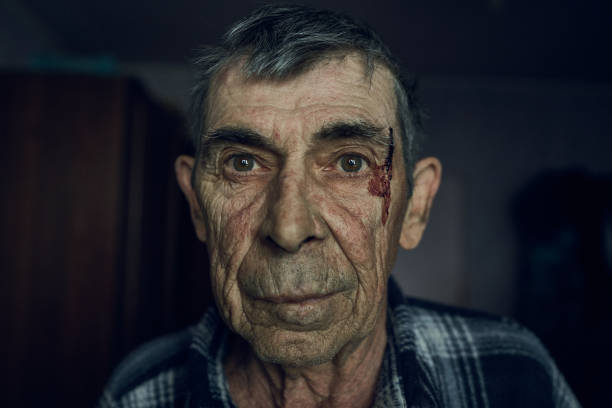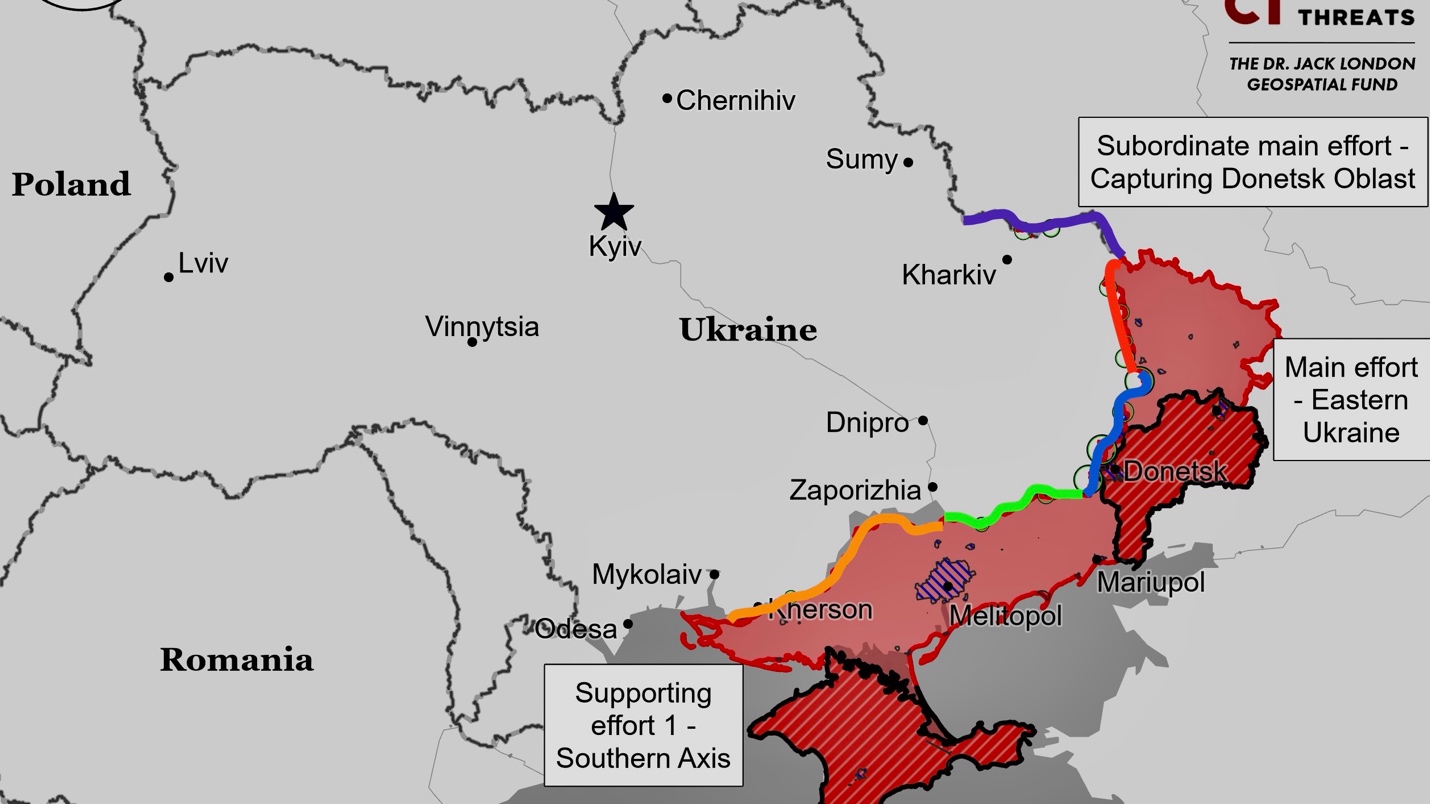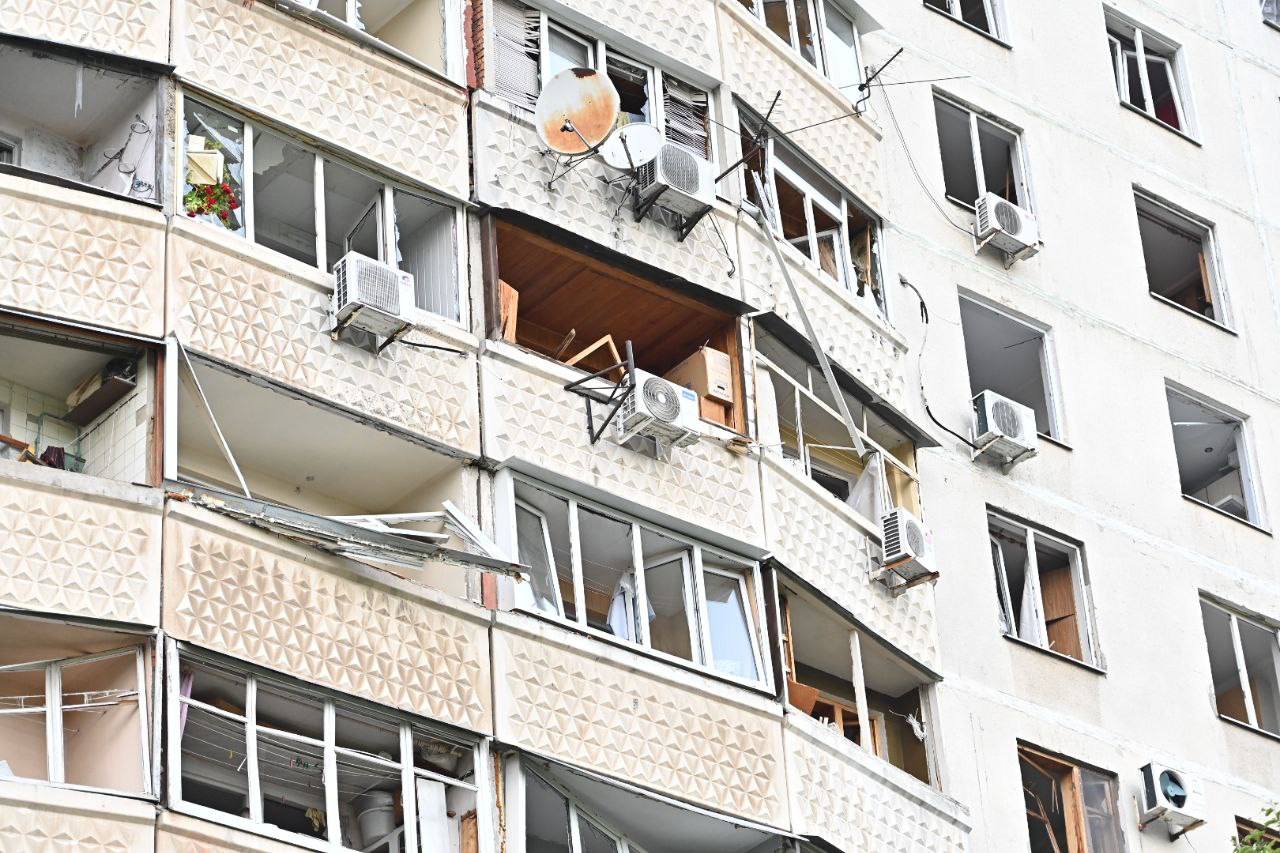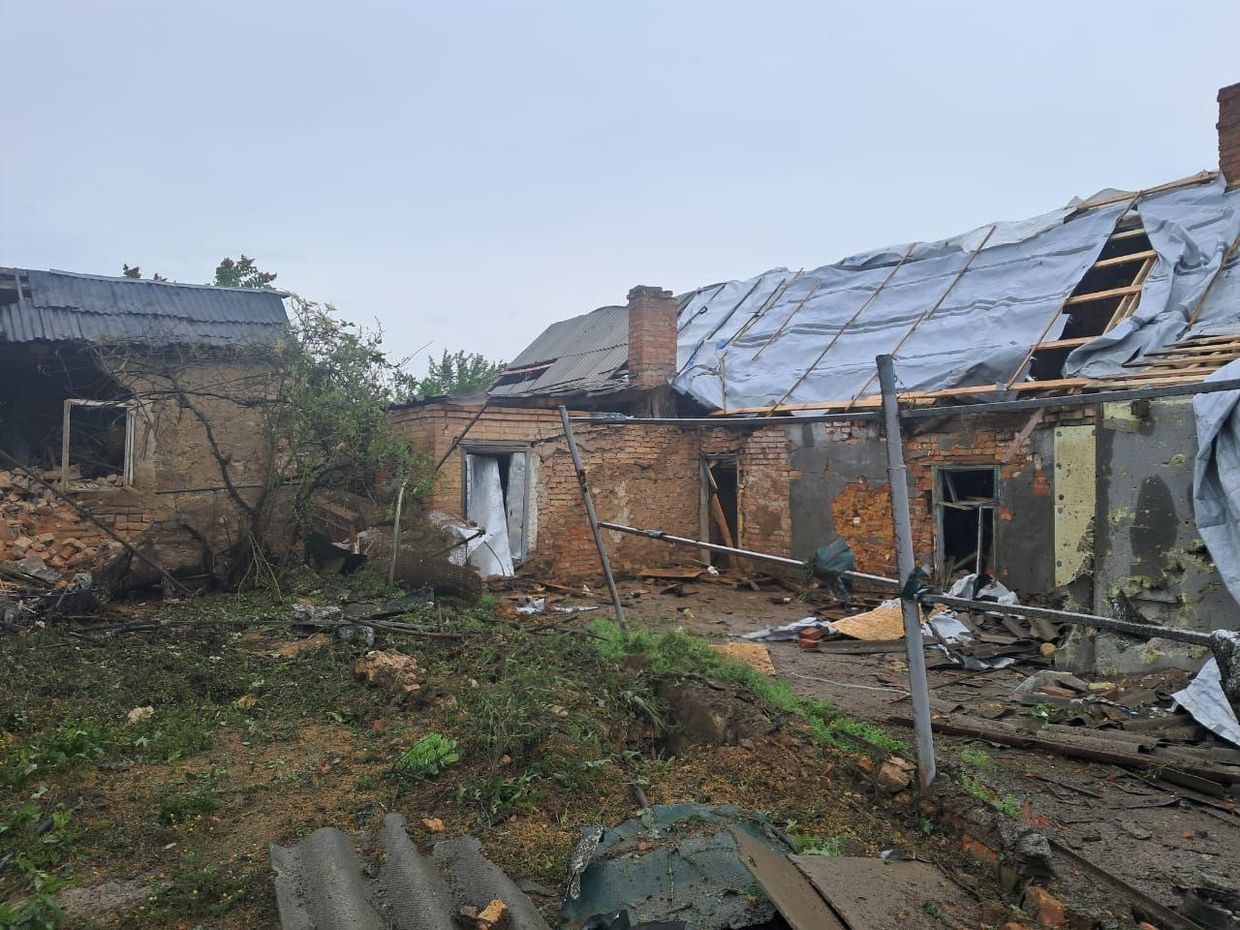Summary of the day: The pace of Russian offensive operations in northern Kharkiv Oblast has slowed, indicating a focus on creating a “buffer zone” rather than deeper penetration into the region. Russian forces made marginal advances near Lyptsi, Vovchansk, Svatove, Chasiv Yar, Avdiivka, Donetsk City, and Krynky. Meanwhile, Russian authorities detained Deputy Defense Minister Yuri Kuznetsov on bribery charges, and President Putin appointed Alexei Dyumin and Nikolai Patrushev as presidential assistants. US Secretary of State Antony Blinken expressed interest in a bilateral security agreement with Ukraine during his visit to Kyiv.
What Can I Do To Help Ukraine? This is a question I receive all the time. We at Transform Ukraine are building longer-term housing for internally displaced Ukrainians. Visit Rebuild Ukraine for how you can assist in housing a Ukrainian family displaced by the war.
Picture Of The Day
 An injured elderly man looks on following a Russian air strike on May 14, 2024 near Kharkiv that injured at least 21 people, including three children. (Vlada Liberova/Libkos/Getty Images)
An injured elderly man looks on following a Russian air strike on May 14, 2024 near Kharkiv that injured at least 21 people, including three children. (Vlada Liberova/Libkos/Getty Images)
Beyond Ukraine – March Towards World War
Georgia’s parliament passed the controversial “foreign agents” bill with an 84 to 30 vote, despite ongoing protests in Tbilisi. The bill requires organizations receiving foreign funding to be labeled as “foreign agents,” raising concerns about stifling opposition and civil society. Backed by the Georgian Dream party, the law mirrors Russian legislation used to suppress Kremlin critics, earning it the nickname “Russian law.” Critics, including opposition figures and Western officials, fear it could lead to domestic repression and hinder Georgia’s EU membership prospects. President Salome Zurabishvili has pledged to veto the bill, but parliament likely has the votes to override her veto. White House Press Secretary Karine Jean-Pierre warned that if the bill is approved, the U.S. may reassess its relationship with Georgia, criticizing the legislation for contradicting democratic values and moving Georgia away from EU and NATO ideals. The bill has sparked mass protests and violent crackdowns, drawing condemnation from Western allies. U.S. Assistant Secretary of State Jim O’Brien echoed these concerns, warning of consequences if the law is enacted.
Moldova and the EU plan to sign a security agreement next week to enhance cooperation in defense, cyber threats, and foreign interference. Relations between Chisinau and Moscow have deteriorated since Russia’s invasion of Ukraine, with concerns about potential spillover through Transnistria, where Russian troops are stationed. Chisinau has moved closer to Europe, signing a defense deal with France in March after warnings of Russian destabilization efforts. The EU proposal includes increased intelligence sharing, joint military exercises, and inclusion in joint weapons procurement. While Moldova’s neutrality clause rules out NATO membership, this pact would significantly link its defense to Western partners. President Maia Sandu, running for re-election in October, has steered Moldova towards the EU, securing membership candidacy and accession talks.
Situation On The Land, Sea, and Air in Ukraine

Kharkiv Front – Initiative Russia
Luhansk Front – Initiative Russia
Donetsk Front – Initiative Russia
Zaporizhia Front – Initiative Russia
Kherson (Dnipro River) Front – Initiative None
Russian offensive operations in northern Kharkiv Oblast have slowed, with Russia focusing on creating a “buffer zone” near the border. The situation in Kharkiv is stabilizing as more Ukrainian units defend the area. Ukrainian forces are targeting Russian groups in Vovchansk, where Russia is employing small assault groups to penetrate positions. Drone footage confirms these tactics in Vovchansk.
Russian forces are using small assault groups, which may be causing higher losses and slowing their offensive. A former Russian military instructor criticized this tactic as a sign of poor training. Ukrainian sources report high Russian casualties, with up to 1,740 soldiers lost in a day. This heavy loss rate is slowing Russian operations, likely leading them to focus on consolidating positions and creating a “buffer zone” near the border instead of advancing further into Kharkiv Oblast.
Russian forces have made tactical advances in and around Vovchansk and near Lyptsi in Kharkiv Oblast. Geolocated footage shows progress in these areas, including the intersection of Skhilna Road and Chervonyi Lane in Lukyantsi. Russian sources claim control of Lukyantsi, but this is not confirmed. Ukraine’s General Staff reported repositioning troops near Lukyantsi due to intense attacks, while fighting continues near Vovchansk. Russian forces partially succeeded near Lukiantsi on May 13. Ukrainian units are countering attacks from Shebekino towards Vovchansk, and the situation is described as under control. Governor Oleh Syniehubov reported 7,023 civilians evacuated from Kharkiv Oblast. Military intelligence chief Kyrylo Budanov stated the situation in Kharkiv Oblast is stabilizing and expects the Russian offensive to shift to Sumy Oblast within days. Ukrainian forces remain on high alert for potential new offensives.
Russian forces made a confirmed advance northwest of Svatove. Geolocated footage shows a marginal advance southeast of Stelmakhivka. Russian forces continued assaults northeast of Kupyansk near Synkivka, Vilshana, Lyman Pershyi, and Petropavlivka, and southeast near Krokhmalne and Berestove. They also attacked west and southwest of Svatove, west and southwest of Kreminna, and south of Kreminna near Bilohorivka.
Russian forces continued ground attacks near Siversk, northeast of Bakhmut. They advanced east of Siversk near Verkhnokamyanske, southeast near Ivano-Darivka and Spirne, and south near Rozdolivka and Vyimka.
Russian forces made minor advances northeast and east of Chasiv Yar. Geolocated footage shows advances on the eastern outskirts of Kalynivka and in the Kanal Microraion of Chasiv Yar. Russian sources also claimed progress in the dacha area north of Kanal Microraion and near Bohdanivka, but this is not confirmed. Ukrainian forces adjusted positions in the Kramatorsk direction. Russian attacks continued near Novyi Microraion, Ivanivske, Klishchiivka, and Bila Hora.
Russian forces made minor advances west of Avdiivka. Geolocated footage shows they advanced south of Umanske to the S-051801 road. Russian sources also claimed advances south of Pervomaiske and within Netaylove, but this isn’t confirmed. The Ukrainian General Staff reported repositioning and some Russian tactical successes in the Pokrovsk direction. Russian ground attacks continued northwest of Avdiivka near several settlements and west of Avdiivka near Umanske, Semenivka, and Yasnobrodivka.
Russian forces made minor advances west of Donetsk City. Russian sources claimed progress in Krasnohorivka and the Kurakhove direction. Ground attacks continued west of Donetsk City near Heorhiivka and southwest near Novomykhailivka and Vodyane.
Russian forces continued ground attacks near Staromayorske and Urozhaine, south of Velyka Novosilka, in the Donetsk-Zaporizhia Oblast border area.
Russian forces continued ground assaults in western Zaporizhia Oblast with no confirmed frontline changes. A Russian milblogger claimed advances northwest of Verbove, but this isn’t confirmed. Russian forces also attacked near Robotyne from Novoprokopivka. Ukrainian forces have reportedly increased drone operations in the area.
Russian forces made minor advances in Krynky during ongoing fighting in eastern Kherson Oblast. Geolocated footage shows Russian forces reaching Ostapa Vyshni Street in Krynky. They continued assaults from the Oleshkivsky Pisky nature reserve and near Kozachi Laheri. Ukrainian officials reported that Russian attacks are now focused on Krynky, with no recent assaults on Nestryha Island.
Ukrainian Civilian Victims Of War
The casualty count of Ukrainian civilians in the past 24 hours:
DEATHS: 7 INJURIES: 34
- Russian airstrikes on Kharkiv city injured at least 21 people, including three children. The attacks damaged a 12-story apartment building and at least 10 garages. The number of injured rose to 21, with more injured civilians expected to be found in the rubble. Russian forces used UMPB D-30 bombs, damaging nearly 20 apartment buildings, an educational institution, and 13 vehicles, while destroying four cars and 15 garages. Earlier, Russian forces also attacked with UMPB D-30 bombs, causing additional damage and casualties.
- Russia’s offensive on Vovchansk in northern Kharkiv Oblast killed two elderly civilians. Russian forces are using all types of weapons against civilians. An 80-year-old woman was killed in Vovchansk, and an 83-year-old man was killed in the nearby village of Hatyshche. Active firefights continue on the northern outskirts of Vovchansk. Over 7,500 civilians have been evacuated from the region, including about 5,000 from Vovchansk and nearby villages. Around 200 to 300 people remain in Vovchansk as Russian troops advance.
- In other attacks on Kharkiv Oblast, a 52-year-old man and a 66-year-old woman suffered shock after a Russian attack involving two glide bombs. Two women, aged 38 and 56, were injured. The attack damaged seven residential buildings, garages, and cars.
- Two volunteers have been missing for four days in Vovchansk, Kharkiv Oblast, and may have been shot by Russian troops. Tamaz Gambarashvili, head of Vovchansk City Military Administration, said the volunteers traveled to Vovchansk without coordination and disappeared. Serhii Bolvinov, head of the regional police investigative department, indicated preliminary information suggests they could have been shot by Russian forces, with eyewitnesses suggesting one might be dead. The Kharkiv Oblast Prosecutor’s Office also reported other possible civilian killings in the area, including a 46-year-old resident shot by a Russian officer and another missing person.
- Russian shelling of Nikopol in Dnipropetrovsk Oblast on May 14 killed a 45-year-old man and injured a 47-year-old man.
- Russian attacks on Kherson Oblast damaged 16 houses, a high-rise building, critical infrastructure, a port, an educational institution, and an administrative building. One person was killed and two were injured.
- Russian troops attacked the border town of Snovsk in Chernihiv Oblast with cluster munitions, injuring four people.
- Russian forces attacked 13 communities in Sumy Oblast, injuring one person in Druzhbivka. Russia used mortar, artillery, missiles, and drones, with drones dropping explosives on three communities. A total of 237 explosions were recorded in 48 attacks, with Velyka Pysarivka, near the Ukraine-Russia border, experiencing the most intense shelling with 65 explosions.
 The aftermath of the Russian strike in the center of Kharkiv
The aftermath of the Russian strike in the center of Kharkiv
 The aftermath of Russia’s attack on the city of Nikopol
The aftermath of Russia’s attack on the city of Nikopol
Ukraine News
Russian forces launched 18 Shahed-136/131 drones and an Iskander-M missile at Ukraine. Ukrainian Air Force Commander Mykola Oleshchuk reported that all 18 drones were shot down over multiple oblasts including Kyiv and Dnipropetrovsk. However, the New York Times reported that Ukraine’s air defenses are struggling to keep up with Russian missile attacks. Ukrainian Air Force Spokesperson Major Ilya Yevlash stated that due to limited air defense supplies, Ukraine is using “non-standard” methods and constantly moving defense systems to counter Russian tactics.
Ukrainian President Volodymyr Zelensky met with U.S. Secretary of State Antony Blinken in Kyiv. Zelensky thanked Blinken for the $61 billion in U.S. aid passed by Congress, highlighting its importance despite expected delays in battlefield impact. Zelensky emphasized the urgent need for air defenses, requesting two Patriot systems for Kharkiv. They discussed the battlefield situation, further defense cooperation, the upcoming global peace summit, and a bilateral security agreement. Zelensky expressed gratitude to the American people and leadership for their support in Ukraine’s fight for freedom.
Ukraine imposed nationwide energy restrictions due to a significant power shortage, following intensified Russian missile and drone strikes that damaged several thermal power plants, including the Trypillya plant. A large-scale Russian attack on May 8 targeted energy infrastructure in multiple regions, leading to the decommissioning of two hydroelectric power plants. Ukrenergo announced emergency shutdowns from 9 p.m. to midnight on May 14 and additional restrictions for industrial users on May 15 due to increased electricity consumption and recent infrastructure damage. Similar measures were previously applied on May 10.
According to a Kyiv International Institute of Sociology (KIIS) poll, half of Ukrainian refugees in Germany, Poland, and Czechia are “less likely to return” to Ukraine. Eurostat data shows over 4.2 million Ukrainian refugees are registered in the EU, with Poland hosting about 1 million. The poll found that 66% of refugees are satisfied with their lives in these countries. While 7% have obtained new citizenship and 12% have applied, 45% want to acquire it. Safety and reliable infrastructure are key factors for those considering returning, but 26% won’t go back until the war ends. KIIS executive director Anton Hrushetskyi noted that many refugees are losing their connection with Ukraine and face tough decisions about settling abroad or returning. The poll shows an increase in hesitance compared to a January study where 64% planned to return.
Ukraine’s Allies
The EU Council approved the Ukraine Plan, setting the stage for a €50 billion ($54 billion) recovery and reconstruction assistance program. This includes €33 billion ($36 billion) in loans and €17 billion ($18 billion) in grants. The approval allows the European Commission to disburse up to €1.89 billion ($2 billion) in pre-financing before regular payments start. Kyiv has already received two pre-financing tranches totaling €6 billion ($6.4 billion). Future payments will depend on Ukraine implementing agreed reforms and investments. The plan also outlines modernization and reform efforts towards EU accession. Belgian Finance Minister Vincent van Peteghem emphasized the EU’s commitment to Ukraine’s stability and growth.
U.S. Secretary of State Antony Blinken, during his visit to Kyiv on May 14, announced that the U.S. seeks a bilateral security agreement with Ukraine. He mentioned that over 32 NATO countries are negotiating 10-year security commitments with Ukraine, with nine agreements completed. Blinken reaffirmed America’s long-term commitment to Ukraine’s security, emphasizing sustainable, long-term support. He highlighted that over 30 countries, including the U.K., Germany, and France, have signed the G7 Joint Declaration of Support for Ukraine. Blinken discussed new U.S. security assistance and long-term support with Ukrainian President Volodymyr Zelensky and Prime Minister Denys Shmyhal. He highlighted plans for a ten-year U.S.-Ukraine security agreement, covering various defense capabilities, and assured that the U.S. will coordinate support if Ukraine faces attacks, reiterating the goal of integrating Ukraine into NATO. Addressing concerns about U.S. aid, Blinken outlined a plan for Ukraine to become self-sufficient militarily, economically, and democratically. He stressed the importance of continued U.S. military aid and domestic defense production in Ukraine, along with ongoing anti-corruption efforts to ensure a robust and independent Ukraine.
The U.K. will not force Ukraine to accept a peace treaty that involves losing territory, Defense Secretary Grant Shapps said in an interview with Times Radio. This follows a Sunday Times report that U.K. Foreign Secretary David Cameron allegedly pitched a peace plan to presumptive Republican nominee Donald Trump. The U.K. government affirmed that its stance on Ukraine remains unchanged. Shapps emphasized that the decision is entirely up to Ukraine and rejected any notion of the U.K. pressuring Ukraine to give up territory. The U.K. has been a strong ally of Ukraine, recently announcing a £500 million ($628 million) defense aid package.
Estonian Defense Minister Hanno Pevkur clarified that Estonia is not currently sending troops to non-combat roles in Ukraine. While National Security Advisor Madis Roll mentioned the idea is under consideration, Pevkur emphasized there have been no specific discussions in Estonia or the EU, and Estonia would not act alone. He stressed the priority is providing ammunition and training to Ukrainian forces.
The Latvian government will allocate an additional €10 million ($11 million) to a Czech-led initiative to purchase artillery shells for Ukraine, as announced on May 14. This initiative, supported by multiple countries, aims to deliver 1.5 million rounds to Ukraine, with the first batch expected in June. Latvian Prime Minister Evika Silinia and Defense Minister Andris Spruds confirmed the funding, enabling the purchase of over 3,000 rounds of 155 mm shells.
Life in Russian-Occupied Ukraine
Ukrainian officials are working to return deported children from Russia. The Ministry for Reintegration announced a new procedure for identifying, returning, and supporting these children, including orphans. Save Ukraine, a humanitarian NGO, rescued six more children from Russian-occupied territories. The rescued children, aged five to 12, were at risk of being sent to Russian “health camps.” The mission faced delays and intimidation. The children are now receiving psychological and medical support.
Russian occupation forces are forcibly transporting Ukrainian citizens. Between January and March 2024, at least 72 civilians from Kherson and Zaporizhia were taken to Crimea for trial. Overall, 201 Ukrainian citizens have been detained for political and religious reasons, including 218 people in Crimea, with 133 being Crimean Tatars.
Russian authorities are also trying to indoctrinate Ukrainian children. On May 12, the Ukrainian Resistance Center reported that occupation officials taught Soviet history to children for Russia’s Victory Day. In Kherson, 1,200 teenagers will be sent to a Russian university for a cultural program, and 100 Donetsk State University students were sent to Moscow to promote pro-Russian narratives.
Russia News
Several freight train cars in Russia’s Volgograd Oblast were derailed due to “interference by unauthorized persons,” according to TASS. The incident occurred at Kotluban station, about 40 kilometers north of Volgograd and 330 kilometers east of the Russo-Ukrainian border. Footage shows the aftermath of a suspected Ukrainian drone strike on a fuel train in Samofalovka. The Baza Telegram channel claimed a drone attack caused the derailment, with two fuel wagons catching fire and one exploding, derailing nine cars in total.
At least 16 people were killed and 27 injured in Belgorod, Russia, after part of a 10-story apartment building collapsed on May 12. Belgorod Governor Vyacheslav Gladkov claimed the building was hit by a Ukrainian projectile during an air raid alert. The Russian Defense Ministry stated that air defenses shot down six Tochka-U missiles and six rockets, with a missile fragment allegedly damaging the building. However, Andrii Kovalenko from Ukraine’s National Security and Defense Council disputed these claims, suggesting the incident might be an internal accident or a provocation. The Kyiv Independent could not verify the claims. Reports of attacks on Belgorod Oblast, which borders Ukraine, have been frequent in recent months.
Lieutenant General Yuri Kuznetsov, head of the personnel department of the Russian Defense Ministry, was detained on May 13 for accepting large bribes, with authorities finding over $1 million in cash and luxury items at his home. Kuznetsov allegedly accepted bribes from businessman Lev Martirosyan to secure government contracts for his hotel companies. The investigation, conducted by the Main Military Investigation Department, is part of a broader probe into high-ranking military officials. Kuznetsov previously led the General Staff’s Eighth Directorate from 2010 to 2023, responsible for protecting state secrets.
Putin appointed former Tula Oblast Governor Alexei Dyumin and former Security Council Secretary Nikolai Patrushev as his presidential assistants. Dyumin will handle defense industry, State Council, and sports policy, while Patrushev will oversee strategic shipbuilding. Dyumin’s appointment aligns with Putin’s efforts to restructure the economy for prolonged conflict. Patrushev’s move is seen as a demotion, surprising many, but he remains a close ally and influential figure.
Russian Mobilization and Defense Industrial Base
Russian President Vladimir Putin’s candidate for Defense Minister, Andrei Belousov, outlined his priorities, emphasizing the integration of the military economy with the general economy, embracing innovation, and prioritizing modern equipment and supplies for the military. Belousov, set to replace Sergei Shoigu, highlighted the importance of the 2025 state defense order and recruitment efforts but ruled out emergency mobilization measures. He stressed the need for optimized spending and better control over the defense industry, aligning with Putin’s goals for a prolonged war effort in Ukraine and potential future conflicts with NATO. Belousov also noted the importance of adapting combat methods due to Ukraine’s quick learning on the battlefield and acknowledged issues in military recruitment and education.
The Russian Ministry of Defense (MoD) is reportedly coercing citizens and migrants into military service through false job offers, promising a one-time payment of 405,000 rubles ($4,400). Recruits are sent to fight in Ukraine under these deceptive contracts. This scheme targets citizens from Russia, Belarus, Kazakhstan, Kyrgyzstan, Uzbekistan, India, and Congo.
Rosgvardia (Russian National Guard) Head Viktor Zolotov confirmed that Rosgvardia units in Ukraine are using heavy weaponry, including tanks, mortars, and artillery systems, specifically in occupied Donetsk Oblast.
The Russian government is likely nationalizing defense industries, as seen with the Yaroslavl Shipyard’s assets being seized by Yaroslavl Oblast’s Arbitration Court.
A Kremlin-linked milblogger reported that the Russian MoD and Tula Oblast government are developing unmanned naval drones, with footage showing a drone with a 250-kilometer range and a 250-kilogram warhead being tested in Tula Oblast.
Russia’s Allies
Russian President Vladimir Putin will visit China on May 16-17 to meet with Chinese President Xi Jinping, RIA Novosti reported on May 14. This will be Putin’s first trip abroad since starting his fifth term. The leaders will discuss their bilateral partnership and strategic cooperation, signing a joint statement and several bilateral documents. Putin will also meet Chinese Premier Li Qiang and attend the opening of the Russian-Chinese EXPO and Forum on Interregional Cooperation in Harbin. Despite China’s neutral stance on Russia’s war in Ukraine, Beijing has been a key economic ally for Moscow amid Western sanctions.
Russian Narratives and Propaganda
Russian officials and pro-Kremlin actors are conducting information operations to discredit the Ukrainian government and undermine morale. They claim the Ukrainian military is unprepared for Russian offensives in northern Kharkiv Oblast, exaggerate Russian successes, and accuse the Ukrainian government of corruption and unethical practices related to the war.
Foreign Minister Dmytro Kuleba called the claim that Ukraine rejected a 2022 peace deal from Russia “one of the favorite lies promoted by Russia.” In a video address, Kuleba said Russia spreads this disinformation to shift blame for the war onto Ukraine. He noted that while Russian and Ukrainian delegates met in early 2022, their positions were far apart, and Russia’s demands were unrealistic. Kuleba also refuted the theory that former U.K. Prime Minister Boris Johnson sabotaged the talks, stating negotiations continued long after Johnson’s visit. Kuleba emphasized that Russian President Vladimir Putin is the true obstacle to peace in Ukraine.
Source Materials
Institute for the Study of War – understandingwar.org
The Kyiv Independent – kyivindependent.com
Kyiv Post – kyivpost.com
